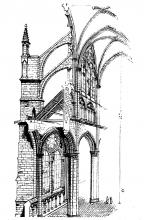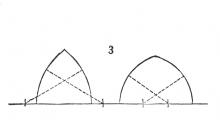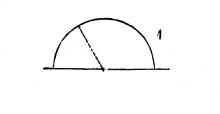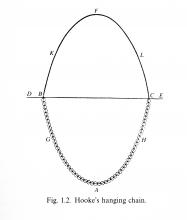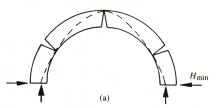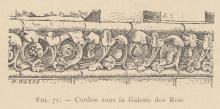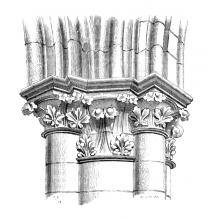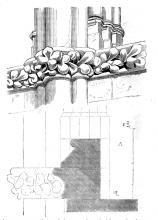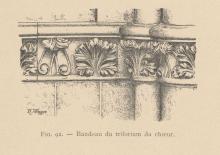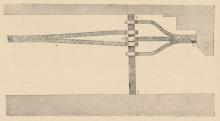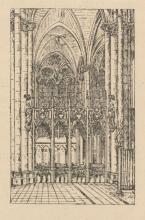In this image of the wooden tie beams, we can see the tie beam still in place (right) and cut out (left).
Graphics
Carpentry
-
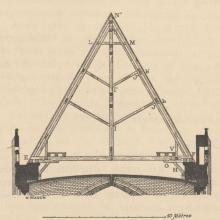
Roof Section of Nave (left) and Choir (right) (Durand)
-

Steeple Elevation, c.1530 (Durand)
-
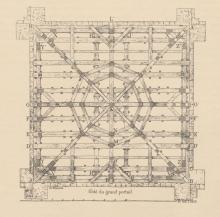
Spire platform, c. 1530 (Durand)
-

Spire sections (Durand)
-
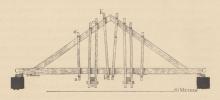
Steeple Trussed Brace (Durand)
-

Steeple Trussed Brace Stirrups (Durand)
-
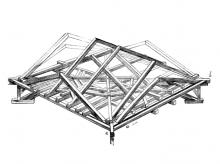
Steeple Platform (Viollet-le-Duc)
-
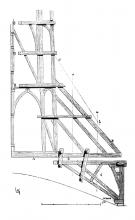
Steeple Base (Viollet-le-Duc)
-
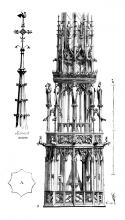
Steeple Elevation (Viollet-le-Duc)
-
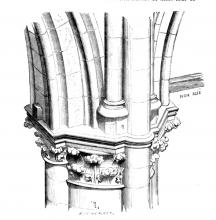
Wooden Tie Beams (Viollet-le-Duc)
-
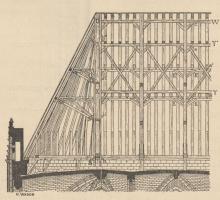
Long Section of Choir Roof (Durand)
-
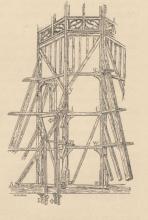
Spire Base (Durand)
-

Spire Support Bracket (Durand)
-
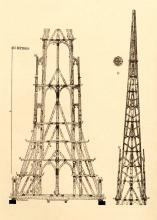
Structural Frame of Spire (Durand)
Elevations
-
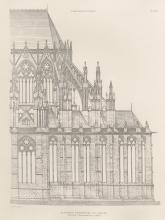
Hemicycle Exterior Longitudinal Elevation (Durand)
Here on the left you can see the last straight bay of the chevet with its characteristic three-oculi aisle window done by Thomas de Cormont and to the right the crown of radiating chapels also done by Master Thomas. Everything above the aisle roof is the work of Master Renaud: note how the buttress uprights have been reduced in mass. The elevation shows the older arrangement of aisle roofs in the choir with double-sloped surfaces intended to allow light to penetrate to the glazed triforium.
-
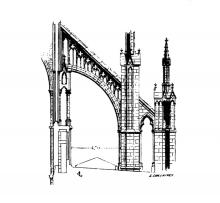
Choir Flyer (Viollet-le-Duc)
-
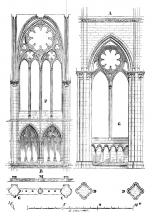
Elevation of Nave Bay (Viollet-le-Duc)
-
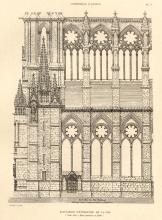
Nave Exterior Elevation (Durand)
-
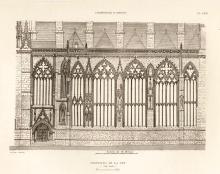
Nave Elevation of Southern Chapels (Durand)
-
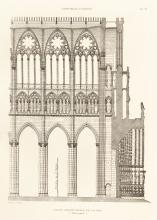
Nave Interior Elevation (Durand)
-
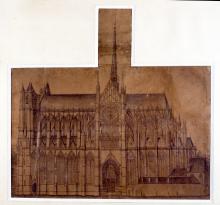
Elevation of North Side (St. Marc Plan)
Collections du Musée de Picardie, Amiens, Anonyme, France, vers 1727, Coupe longitudinale de la Cathédrale d’Amiens, plume sur papier, collection du Musée de Picardie, Amiens, no inv. : M.P.2072-32, , photo Ludovic Leleu/Musée de Picardie
Foliage
Historic Views
-
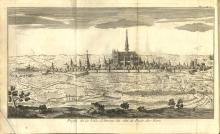
Amiens from the south (engraving, Abbé L.F. Daire, 1757)
Engraving from Abbé L. F. Daire, Histoire de la ville d'Amiens, 2 vols., 1757
-
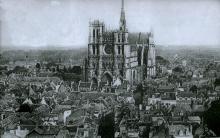
Cathedral seen from Belfrey, 1880s
-

Amiens from the West under Siege (Porfille, 1597)
Engraving by Claude Chatillon, Topographe du Roy, Amiens, Archives diocésaines.
-
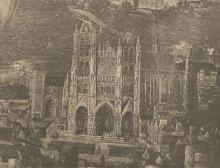
View of Amiens Cathedral 1520
-
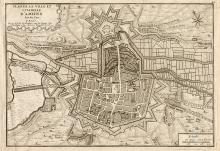 Plan of Amiens c.1716Plan of the City and Citadel of Amiens. 1716, Amiens, Archives diocésaines.
Plan of Amiens c.1716Plan of the City and Citadel of Amiens. 1716, Amiens, Archives diocésaines. -
Vue Rétrospective et Panoramique d'Amiens en 1781
Collections du Musée de Picardie, Amiens, Aimé et/ou Louis Duthoit (1803 – 1869) ( 1807 – 1874) : Vue panoramique d’Amiens en 1721 depuis le nord, d’après Jean Gourdain (vers 1840 – 1850), encre et aquarelle sur papier blanc, collection du Musée de Picardie, Amiens, photo Com des images/Musée de Picardie
Language of Articulation
-
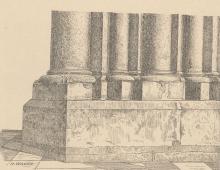
Crossing Pier Plinth (Durand)
The main crossing piers have a stepped core with colonnettes set to receive the transverse arches and diagonal ribs.
The unit sits atop an octagonal raft Each colonnette has its own plinth and its own base molding. -
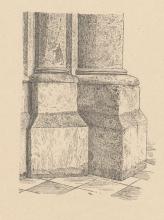
Aisle Respond (Durand)
-

Arch and Rib Profiles (Durand)
In this image, from left to right, depicts the ambulatory transverse arch (fig. 22), the diagonal rib (fig. 23), and the nave aisle transverse arch (fig. 24). The ambulatory transverse arch with its intense linearity dates to the work of Master Renaud in the 1250s. The diagonal rib profile appears in both the nave and the choir. The nave aisle transverse arch dates to the work of Master Thomas and Renaud in the 1230s.
-
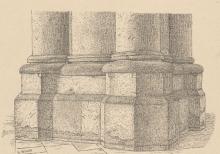
Nave Pier Plinth (Durand)
The main body of the pier sits atop an octagonal plinth and each of the colonnettes has its own octagonal plinth creating a complex prismatic composition.
-
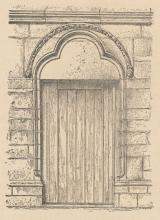
Door into West Side of North Transept (Durand)
-
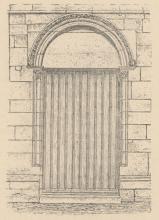
Door into West Side of South Transept (Durand)
-
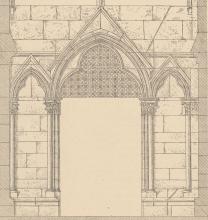
Saint Christophe Portal (Durand)
-
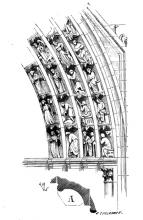
Drawing of South Transept Portal Voussoirs (Viollet-le-Duc)
Liturgical Setup
-
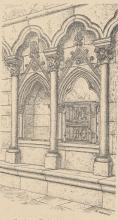
Piscina and Ambry in South Choir Aisle (Durand)
Set in the dado at the east end of the south choir aisle is a piscina to serve in the ceremonial washing associated with the celebration of the Eucharist and an amber or cupboard for storing sacred vessels. The facilities would serve the needs of the priest celebrating Eucharist in the chapel known as Notre-Dame l'Anglette. The trilobed dado is of the kind used by Robert de Luzarches.
-
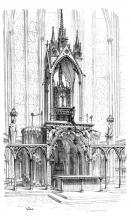
Altar of Sainte-Chapelle (Viollet-le-Duc)
-
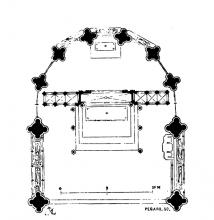
Sanctuary Plan (Viollet-le-Duc)
-
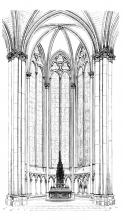
Interior of Radiating Chapel (Viollet-le-Duc)
-
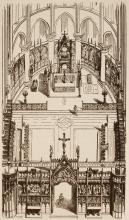
Liturgical Choir of Notre-Dame of Paris (Viollet-le-Duc)
-
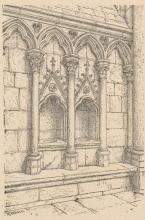
Double Piscina in the Chapel of Saint Quentin (Durand)
Pavement
-
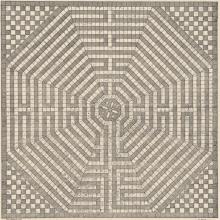
Labyrinth (Durand)
The great labyrinth, spanning 12.14m, was set in the nave pavement by Master Renaud de Cormont in 1288. The decorative pavement including the labyrinth was removed in 1827-8 and replaced with a plain stone pavement. The central octagonal plaque, stripped of the inlaid images of the three master masons and founding bishop, was preserved in the Musee de Picardie. The outcry against this vandalism was so intense that a replica of the original pavement was completed in 1894. The labyrinth invites the visitor to enter into a kind of quest for the discovery of the identity of the master builders. It also played a role in a liturgical celebration where Theseus was seen as a prototype for Christ.
-
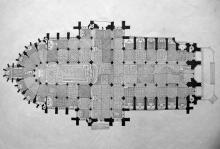
Diagram of Original Pavement Patterns at Amiens
-
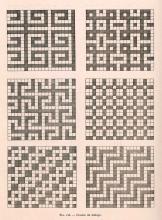
Pavement Diagram
Plans
-
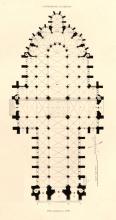
Original Cathedral Floor Plan (Durand)
-
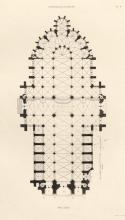
Floor Plan of the Cathedral with Nave Chapels (Durand)
-
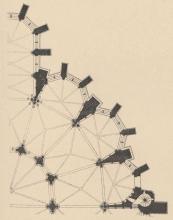
Choir Hemicycle Plan (Durand)
This plan shows two levels of the choir hemicycle: the darkly-shaded elements constitute the uprights of the flying buttresses built by Master Renaud in the 1250-60s which sit on top of the lower buttresses between the chapels installed by Master Thomas more than a decade earlier. You can see that the younger master has not continued the solid rectangular form on the main buttresses, preferring a much daintier "Y" shaped unit. Renaud has then placed intermediary uprights (marked D on the plan) atop the piers dividing the chapels.
-

Hemicycle Buttress Plan (Durand)
-
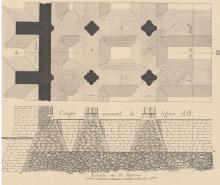
Choir Plan and Section of the Foundations (Durand)
This diagram, published by Georges Durand, originates with Viollet-le-Duc's excavation of the choir foundations. Viollet-le-Duc claimed to have found a gridded raft of stone descending to a depth of around 10 meters. The choir would need such substantial foundations since it sat upon an area that once formed the defensive ditch of the Roman wall.
-

Plan of Nave Triforium (Durand)
-
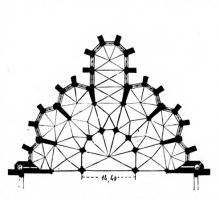
Plan of Hemicycle (Viollet-le-Duc)
-
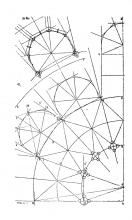
Hemicycle Schema (Viollet-le-Duc)
-
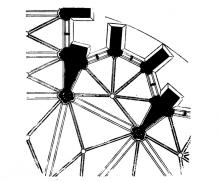
Plan of Radiating Chapels (Viollet-le-Duc)
-
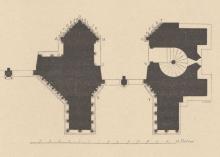
Plan of South Tower of West Façade (Durand)
-
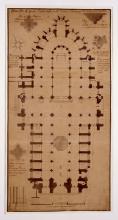
St. Marc Plan
Collections du Musée de Picardie, Amiens, Anonyme, France, vers 1727, Plan de l’église Cathédrale de Notre Dame d’Amiens, plume, crayon et lavis sur papier, collection du Musée de Picardie, Amiens , no inv. : M.P.2072-18, photo Ludovic Leleu/Musée de Picardie
-
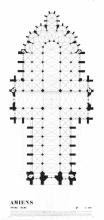
Floor Plan of the Cathedral (Murray-Addiss plan)
-
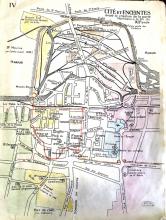 Amiens c.1200 (Massiest du Biest)
Amiens c.1200 (Massiest du Biest) -
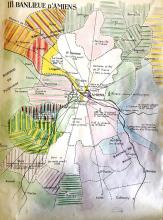 Suburbs of Amiens c.1200 (Massiest du Biest)
Suburbs of Amiens c.1200 (Massiest du Biest) -
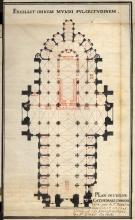 Plan of Amiens Cathedral 1713 Amiens, Archives diocésaines
Plan of Amiens Cathedral 1713 Amiens, Archives diocésaines
Sections
-
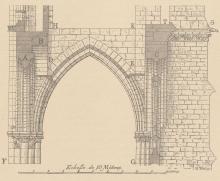
Nave Aisle Transverse Section (Durand)
On the left you see a nave support (pillar cantonné) and the nave arcade whose thickness (2 feet) is slightly less than the diameter of the body of the pier. To the right you see the outer wall of the nave aisle and the massive buttress projecting about 4 meters beyond the outer wall.
The section reveals one of the deceptive features of Gothic. The triforium passage is not actually enclosed in the thickness of the wall, but projects out behind it. Known in French as a "porte-à-faux" this kind of overhang is a common feature of Gothic. -
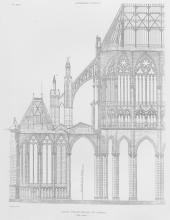
Choir Longitudinal Section (Durand)
This longitudinal section shows the three-story elevation with glazed triforium as the middle level. To the east of the main vessel of the choir is the hemicycle surrounded by an ambulatory. Here you can see the section through the axial chapel. The section provides an excellent understanding of the form of the openwork flying buttresses and the relation of the high vaults to the main roof.
-
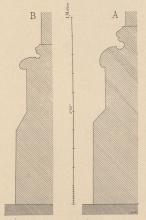
Pier Base Profiles (Durand)
The junction between the body of the pier and the plinth is embellished and softened by a moulding which forms a kind of cushiony pad. The profile allows us to see the upper rounded rim (torus), the deeply grooved middle concavity (scotia) and the lower rim.
The molding resembles those found in the Erechteum, Athens, and are therefore call Attic moldings (from Attica, the country around Athens). As the builders of the cathedral continued their work over a period of decades they continued to adjust the profile to satisfy current taste. The deeply projecting lower torus on the left is characteristic of the early work on the nave, 1220s; the greater height on the right is characteristic of the choir, 1240s. -
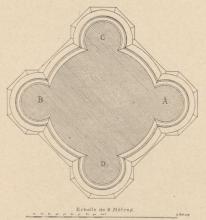
Nave Pier Section (Durand)
The central cylindrical core (diameter 1.38m) is flanked by four colonnettes (0.47m)--this configuration is called a pilier cantonné. Precedents can be found at Chartres and Reims Cathedrals. The dimensions of the unit are matched with those of the main crossing piers to create a main arcade arch of two feet in thickness.
-
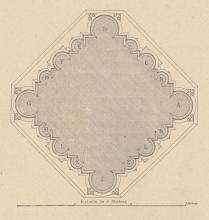
Crossing Pier Section (Durand)
-
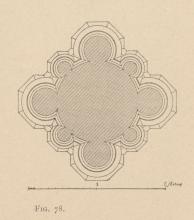
Choir Pier Section (Durand)
The choir is flanked by double aisles with slender intermediary piers supporting the vaults of inner and outer aisles. These supports are formed around a central cylindrical core (diameter?) flanked by eight colonnettes, the major one supporting the transerse arches and the thinner ones supporting the diagonals. The thinner shafts are formed of separate sticks of stone, not coursed in the with main body of the pier. Built my Master Thomas c 1230s-40s.
It should be remembered that these slender units carry the weight of the intermediary uprights of the flying buttresses system. We begin to understand why Master Renaud did his best to make the flying buttresses of the choir as light as possible. -
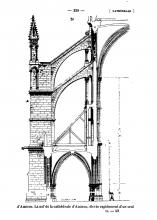
Transverse Nave Section (Viollet-le-Duc)
-
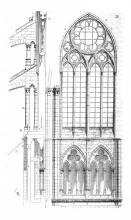
Section and Elevation of the Nave Clerestory (Viollet-le-Duc)
-
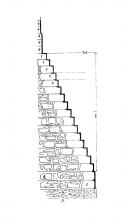
Diagram of Foundations (Viollet-le-Duc)
-
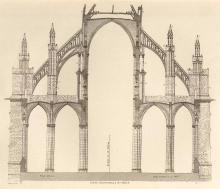
Choir Transverse Section (Durand)
-
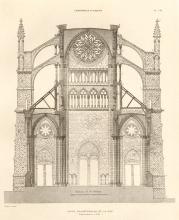
Nave Transverse Section
-
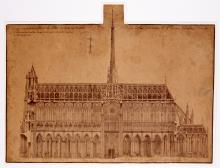
Longitudinal Section (St. Marc Plan)
Collections du Musée de Picardie, Amiens, Anonyme, France, vers 1727, Elévation de façade sud de la Cathédrale d’Amiens, plume sur papier, collection du Musée de Picardie, Amiens, no inv. : M.P.2072-31, , photo Ludovic Leleu/Musée de Picardie -
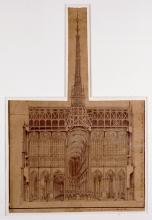
Transept Section (St. Marc Plan)
Collections du Musée de Picardie, Amiens, Anonyme, France, vers 1727, Coupe suivant le transept de la Cathédrale d’Amiens, plume sur papier, collection du Musée de Picardie, Amiens, no inv. : M.P.2072-56, , photo Ludovic Leleu/Musée de Picardie
Tracery Forms
-
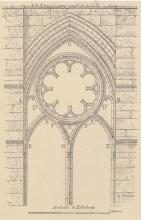
Nave Aisle Window (Durand)
Enclosed inside a steeply-pointed framing arch and with an enormous upper oculus surmounting two uncapped lancets, such windows originally existed along the entire length of the nave aisles. They were torn out in the fourteenth century to make way for the added chantry chapels. Such units still survive in the lower transept arms. The tracery of the windows on the west side of the south transept show signs of experimentation and modification which may suggest that they were the first in the sequence.
-
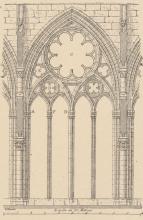
Nave Clerestory Window (Durand)
In the upper nave (c.1240) Master Thomas de Cormont has retained the great central oculus characteristic of the aisle windows but has created four lancets clumped in pairs and surmounted by smaller oculi.
-
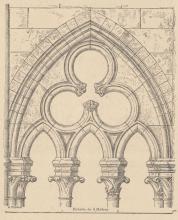
Nave Triforium Tracery (Durand)
The work of Master Thomas, 1230s, the nave triforium features a generously-sized trefoil cut out of a continuous plate of stone (plate tracery). The trefoil surmounts three uncapped lancets.
-
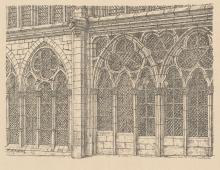
Exterior Glazed Triforium on the East Side of the South Transept (Durand)
-
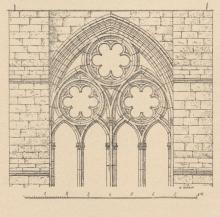
Choir Aisle Window (Durand)
This choir aisle window by Master Thomas (1230s) is framed by an arch which is not as steeply pitched as in the nave aisle (1220s). The earlier windows are dominated by an enormous central oculus over two lancets; now we have three smaller oculi of equal size surmounting four lancets.
-
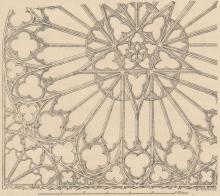
North Transept Rose (Durand)
-
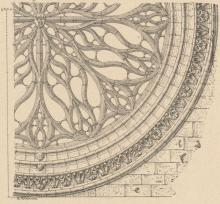
West Rose (Durand)
Probably the work of Master Pierre Tarisel installed c. 1520 this magnificent flamboyant window was given by Robert de Cockerel. The stained glass links the royal lilies with the ivy of Amiens to celebrate the reunification of the city and kingdom after the expulsion of the Burgundians.
-
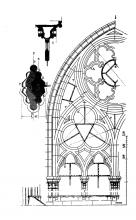
Diagram of Choir Clerestory Window (Viollet-le-Duc)
-
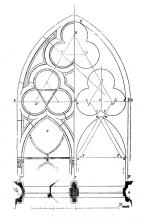
Diagram of Radiating Chapel Window (Viollet-le-Duc)
-
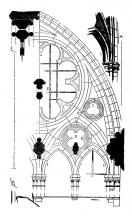
Diagram of Nave Clerestory Window (Viollet-le-Duc)
-

Choir Clerestory and Triforium Tracery (Durand)
The work of Renaud de Cormont in the 1250-60s. Renaud favored the trefoil--a form already used by his father Thomas in the nave triforium. Here, below, you see the reverse side of the choir triforium which is glazed, providing abundant light for the interior of the choir. In the clerestory, above, Renaud has elaborated his trefoils with trilobed cusping and capped the entire window with a gable, lending a "post modern" jagged look to the exterior.
Vaults
-
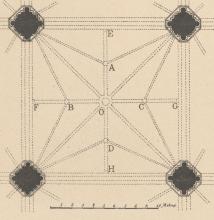
Crossing Vault (Durand)
The star-shaped pattern of the ribs makes this a lierne vault (from the French lier, the link or bind). This kind of vault developed first in England in the mid-13th century (Lincoln nave). Here at Amiens it is likely that the crossing vault was only installed after the completion of the roof, c.1310.
-
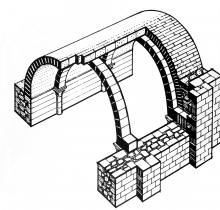
Barrel Vault
-
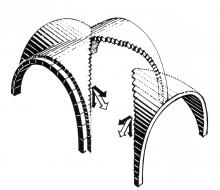
Groin Vault
-
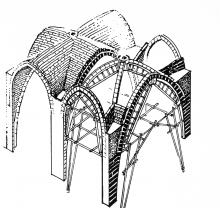
Rib Vault

